主格人称代词和be动词..
- 格式:ppt
- 大小:1.85 MB
- 文档页数:29
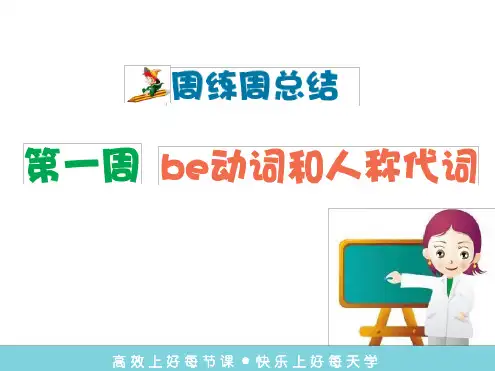
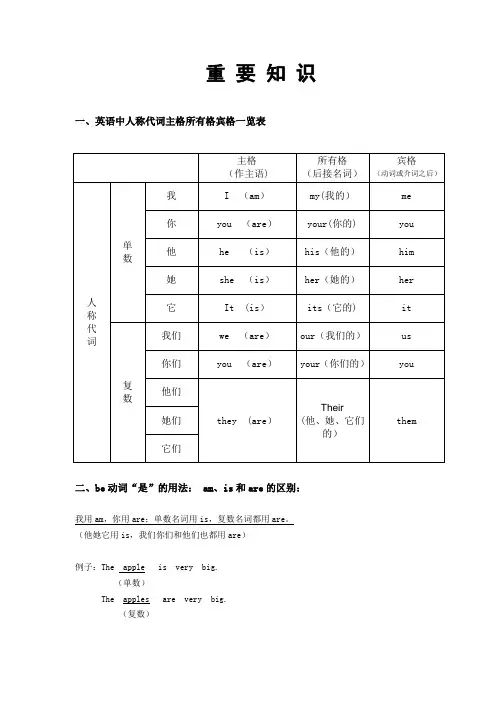
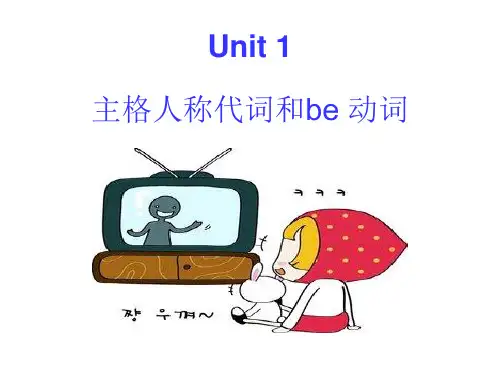
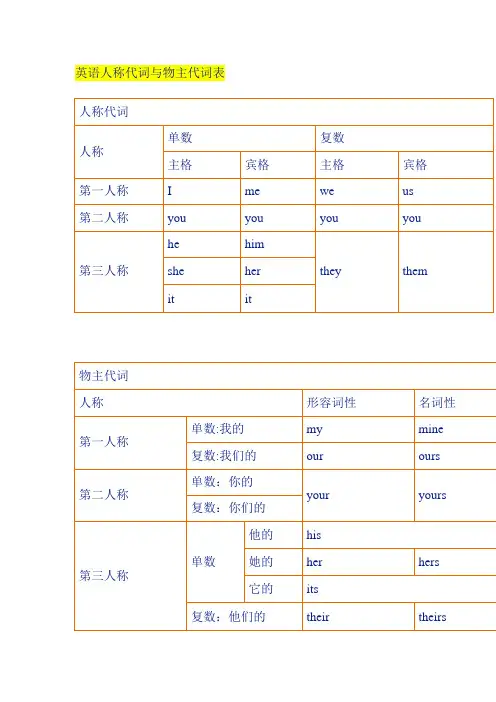

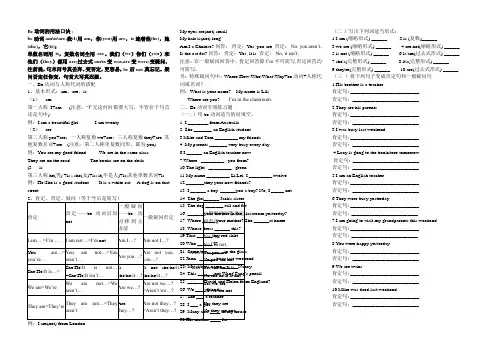
Be 动词的用法口诀 :be 动词am\is\are,我(I)用am ,你(you)用are ,is 连着他(he),她(she),它(it);单数名词用is ,复数名词全用are 。
我们(we )你们(you )和他们(they )都用are;过去式am\is 变was,are 变 were;变疑问,往前提,句末问号莫丢弃。
变否定,更容易,be 后not 莫忘记。
疑问否定任你变,句首大写莫迟疑。
一、Be 动词与人称代词的搭配 1、基本形式:am 、are 、is (1) am第一人称I+am (注意:“I”无论何时都要大写,不管位于句首还是句中)例:I am a beautiful girl. I am twenty. (2) are第二人称you+are; 一人称复数we+are ; 三人称复数they+are 其他复数名词+are (注意:第二人称单复数同形,都为you) 例:You are my good friend. We are in the same class. They are on the road. The books are on the desk. (3 is第三人称he(男) +is ; she(女)+is; it(不是人)+is;其他单数名词+is 例:He\She is a good student. It is a white cat. A dog is on that street.例:I am(not) from London.My eyes are(not) small. My hair is(not) long.Am I a Chniese? 回答: 肯定:Yes, you are. 否定: No, you aren’t. Is the cat fat? 回答:肯定:Yes, it is. 否定: No, it isn’t.注意:在一般疑问回答中,肯定回答除I’m 不可简写,否定回答均可简写。


Module 2—be动词及人称代词和指示代词的用法【概念引入】1. be动词英语中的be动词指的是“am/is/are”的原形,它的意思是“是”。
be动词在句子中作谓语的时候,要根据句子的主语和时态而变化形式。
本单元我们学习的是be动词在一般现在时中的用法。
2. 代词代词是代替名词的一种词类。
大多数代词具有名词和形容词的功能。
英语中的代词,按其意义、特征及在句中的作用分为:人称代词、物主代词、指示代词、反身代词、相互代词、疑问代词、关系代词、连接代词和不定代词九种。
本单元我们主要讲解人称代词和指示代词的用法。
【用法讲解】I. be动词的用法1. 形式变化。
一般现在时中,be动词的形式是“am, is, are”,其具体用法如下:1)如果句子的主语是第一人称单数I的时候,be动词用am在句子中作谓语。
例如:I am a boy. 我是个男孩。
I am six years old now. 我现在六岁了。
2)如果句子的主语是第三人称单数He /She/It的时候,be动词用is在句子中作谓语。
例如:He is a boy. 他是个男孩。
The girl is my sister. 那个女孩是我的妹妹。
3)如果句子的主语是第二人称单数you或者是其他的人称代词复数的时候,be用are 在句子中作谓语。
例如:You are a good boy. 你是一个好男孩。
We are all boys. 我们都是男孩。
2. 缩写规则。
1)am/is/are可以单独使用,也可以和句子的主语(人称代词、名词)缩写。
例如:My name’s Gina. 我的名字是吉娜。
2)am/is/are可以和not缩写构成否定形式。
例如:My family nam e isn’t Green. 我的姓不是格林。
3)is不能和指示代词this缩写。
例如:This is Jenny. 这是珍妮。
不能用This’s Jenny.3. 用法歌诀。

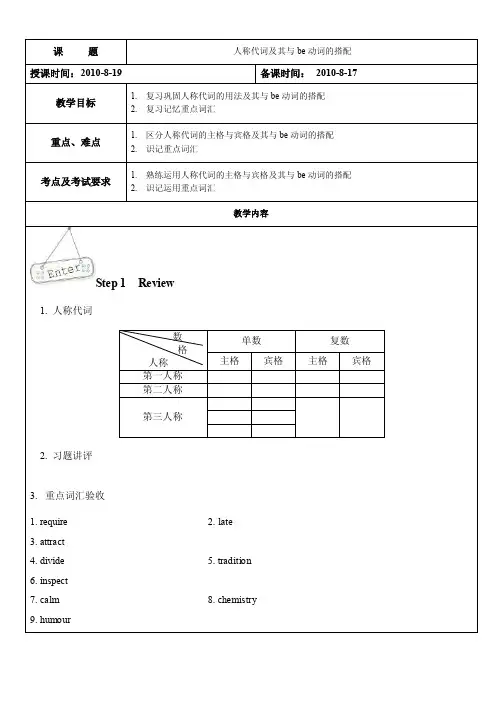
Step 1 Review 1. 人称代词数格人称单数复数主格宾格主格宾格第一人称第二人称第三人称2. 习题讲评3.重点词汇验收1. require2. late3. attract4. divide5. tradition6. inspect7. calm 8. chemistry 9. humour9. _________ don't know her name. Would you please tell _________. ( we )10. So many dogs. Let's count _________. ( they )11. I have a lovely brother. _________ is only 3. I like _________ very much. ( he )12. May I sit beside _________? ( you )13. Look at that desk. Those book are on _________. ( it )14. The girl behind _________ is our friend. (she )15. Can you show _______ (I) your book?16. _________ dresses are red. (we) What colour are _________? ( you )3. 重点词汇1. require2. late3. attract4. divide5. tradition6. inspect7. calm 8. chemistry9. humour10. proud11. prepare 12. pleasant13. international 14. apply15. confident 16. dislike17. rude 18. memoryStep 3 Homework2.查阅并记忆单词3.完成课堂上未做的练习3. 人称代词练习1)________(我) am a teacher.2)My father is talking with _______(我).3)_______(他) often plays basketball after school4)_______(我们) buy a pair of shoes for _______(他).5)Please pass_____(我们) the ball.6)_______(他) often plays basketball after school.7)_____ is my friend. 他是我的朋友。
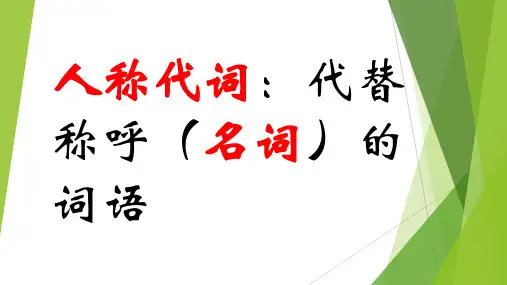
一.认识be动词和主格人称代词。
Be 动词有个,分别为,一般译为。
②主格人称代词有个,分单数和复数。
我,你,你们,她他它,我们,他们.主格在句中做主语,常常和be动词连用.③be动词使用口诀;我(I)用,你(you)用,用于她他它,复数全部都用。
下面根据例句,翻译句子。
例:他是Tom.HeisTom.他们八岁。
They are eight.我是Tony.。
你很开心。
我们是朋友(friends)..他是美国人(America)。
它是我的狗。
.他很害怕。
.她是你的姐姐(sister)。
你九岁了。
二.了解三单数。
三单数的全称为,原则:不是,不是不是就是三单数。
当主语为三单数时,句子中的动词一般加,有时+es,也有一些特殊情况,如;have→has。
例;she paints a red budgie on Monday.Mike likes milk very much。
①我讨厌老鼠。
他讨厌老鼠。
②我很伤心。
Tom也很伤心.。
③她很开心。
你也很开心。
三.默写11—-20的数字。
11 12 1314 15 1617 18 19 20四,翻译下列词句。
1.哭2。
笑 3.跺脚4.另一,又一5.愚蠢的6.但是7.她累了.。
8.你今天感觉怎么样?。
9。
这个游戏(game)很蠢.。
10。
没关系.。
英语人称代词与物主代词表人称代词单数复数人称主格宾格主格宾格第一人称I me we us第二人称you you you youhe him第三人称she her they themit it物主代词人称形容词性名词性单数:我的my mine 第一人称复数:我们的our ours单数:你的第二人称your yours复数:你们的他的his单数她的her hers 第三人称它的its复数:他们的their theirs人称代词和物主代词讲解及练习人称代词及物主代词用法I you he she it we theyme you him her it us them my your his her its our their mine yours his hers its ours theirs课堂实例讲解:一、①第一行都是人称代词主格,放在动词〔行为动词、be 动词、情态动词等〕前面。
如:〔我〕am a teacher。
〔我们〕can play football。
②如果是问句,那么放在助动词、be 动词或情态动词后面。
如: Are〔你〕 a pupil?Do〔他们〕play football?Can〔他〕 walk ?二、第二行都是人称代词宾格,放在动词或介词后。
如: Let me give 〔她〕 some sweets 。
Would you like to go with〔我〕?三、第三行是形容词性物主代词。
形容词性物主代词后面必须是名词。
如:This is〔我的〕potato。
That is〔你的〕tomato。
四、第四行是名词性物主代词。
名词性物主代词后面不用带名词,可以单独使用。
如:This potato is〔我的〕。
That tomato is〔你的〕。